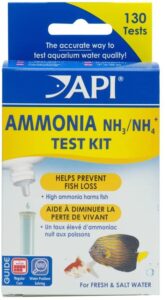It is important to maintain a healthy balance of the aquatic animals in an aquarium. Many things can go wrong in a fish tank if the water doesn’t stay clean. This is why it is important to have an aquarium water quality monitor. It is a great way to keep track of things such as pH, nitrate, nitrite, total ammonia, and dissolved oxygen. In this article, we will focus on aquarium ammonia levels and ways to control them. Maintaining a stable ammonia level is extremely important when it comes to maintaining a healthy aquarium.
But what is NH3 or ammonia?
Ammonia is a chemical compound consisting of hydrogen and nitrogen. It is scientifically termed NH3. It is the result of an organic compound (such as fish waste or food) decaying and producing nitrite, which then decays into ammonia. Ammonia levels should be kept to less than 1 ppm for optimum water conditions. Aquariums are delicate ecosystems in which the fish and the
environment must be kept in balance. Nitrification, a chemical reaction that takes place in both freshwater and saltwater aquariums is what breaks down ammonia to nitrite and then again to nitrate. Nitrate is not harmful, but ammonia is toxic for fish even at very low levels. This article will suggest ways that you can maintain proper levels of ammonia in your aquarium. There are multiple NH3 testers available in the market like API ammonia test kit, API Ammonia Fw/Sw Test Kit, Tetra EasyStrips
What causes ammonia in the fish tank?
A common question about the fish tank is: What causes ammonia in the tank? And the simple answer is: Ammonia is a natural by-product of animal waste and can cause tank inhabitants to suffer from health problems. In addition, high levels of ammonia may contribute to algae growth. Some of the common causes are as follows
Poor aquarium water quality
A majority of aquarium owners, both novice and experienced alike, will experience an issue with the quality of their aquarium water at some point. Some issues can be corrected and dealt with fairly quickly and easily, while others may require a little more time and effort to get under control. One such issue that may require a lot of time and devotion is water quality.
Overfeeding the fish
Many people who have an aquarium know that fish requires the right balance of nutrients to flourish. However, many don’t know how to maintain this balance with ease. Aquarium ammonia level is often caused when the fish are overfed with foods that contain nitrogenous materials such as meat. This can be prevented by feeding them less food and more plants so they will not produce as much ammonia and nitrites.
Too many fish in the tank for the available surface area to swim or eat at once
What are the consequences of overcrowding fish in a tank? According to the National Oceanic and Atmospheric Administration, if left unchecked, an overcrowded tank can lead to stress for all aquatic life. Fish need space to swim because they are constantly on the move in their natural habitat. Overcrowding can also lead to higher levels of ammonia and nitrates in the water, which is not healthy for any fish, no matter what species it may be.
What are the Signs of high Ammonia levels in an aquarium?
It is important to monitor ammonia levels in your fish tank because the health of your fish will worsen over time. If you notice that your fish are not as active or they have difficulty breathing, chances are the ammonia levels in the water are too high. Ammonia is a harmful chemical produced by fish waste. Ammonia will kill off the beneficial bacteria in your aquarium. It can cause fish to go blind and even cause the fish to die, so it can’t be ignored. Following are some of the basic Signs of high Ammonia levels in an aquarium.
Strange smell
When you smell ammonia, the resulting scent is common and often unpleasant for those who encounter it. The reason behind this reaction may be that there are certain characteristics of ammonia that we associate with urine and other bodily fluids. In general, people find the smell to be sour or pungent and reminiscent of disinfectant or cat urine. It is also said to be an irritant and can cause breathing difficulties in those who inhale it. The strong odor of ammonia is caused by its high concentration of nitrogen. Ammonia stays airborne for hours and lingers in the air long after the ammonia has evaporated. The smell of ammonia can be hard to get rid of because it is impossible to cover with other scents.
Frequent bubble formation
There are many causes for frequent bubbles in an aquarium including inadequate filtration, overfeeding, low oxygen levels,s and high ammonia levels. The first step is to make sure the filter is working correctly with the adequate flow to remove waste from the tank. The next step is to reduce feeding or switch to a sinking food if overfeeding is the condition causing the problem.
White sediment on gravel
Although aquarium gravel may look clean and white, it can still be a breeding ground for ammonia. When cleaning the tank, make sure not to dump out all of the gravel into the waste receptacle because you will lose this valuable bacteria colony that has been created over time. Instead, start by removing any large pieces of debris such as fish food and uneaten fish food, snails, and dead plants or other organisms.
Fish gasping for air near the surface
Higher ammonia levels make it difficult for them to breathe. Fish have been found to surface near the water’s surface in a new study. Researchers found that the fish were coming up for air because of a high concentration of ammonia, a gas that is emitted by decaying organisms and waste products. Hence you may see your fish behaving the same.
How to control aquarium ammonia levels?
This is an important task for any aquarist that wants to maintain a healthy environment for their fish, corals, and other aquatic life. Some even see ammonia spikes in new tanks. There are many ways to control aquarium ammonia levels. Some of the most common include increasing aeration, increasing the amount of surface agitation, reducing aerobic bacteria, or “seeding” with nitrifying bacteria. The decision on how to control ammonia levels depends on many factors including fish species, tank size, filter type, and age of tank setup. Some of the effective ways to control high levels of ammonia are covered here.
Replace water with fresh, filtered water
Ammonia is an irritant to fish and can cause them to become sick or die. If you are unsure of how to control ammonia levels in your aquarium, the first thing you should do is replace your water with fresh, filtered water. Even if you are only replacing half of your total water, this can be a great way to lower your ammonia levels. It’s recommended to change 15% of your water every week to dilute the nitrites that accumulate.
Clean or change the filter
Routine water changes are one way to control the ammonia levels in an aquarium. Another option is to change the filter media monthly or weekly, depending on what type of filter you have. Ammonia will get trapped in the filter and if not changed, this can lead to high levels of ammonia in your aquarium. If your tank is heavily stocked with fish, it may be necessary to change the filter more frequently than once a month. You can also use an aquarium siphon to remove water. Another option is to remove the aquarium filter and replace it with one that is designed for a cleaner, healthier aquarium environment. A new mesh filter is the best option, and it should be well-maintained to prevent clogs in the filter.
Check the pH levels
Many of the problems that result from high levels of ammonia such as stress and death can be avoided by regularly testing your tank’s pH levels and maintaining them at a level of 7-8. If you find that the pH level is too low, you can add acidic water to raise the pH levels. If the pH level is too high, you can add water that contains baking soda and vinegar to lower the pH levels. The most common type of other types of chemicals can there are also other types of chemicals that can be used to remove the danger of ammonia. Ammonia levels are usually tested by using a kit or by testing the pH of water samples taken from the tank. If you notice ammonia levels above 100 parts per million, you can use an aquarium ammonia remover to control the ammonia levels in your aquarium. We recommend using chemicals like Seachem Ammonia Alert or API Ammo Lock.
Add aquarium salt to reduce ammonia
To reduce ammonia levels in your tank, add aquarium salt. Adding a tablespoon of salt per 10 gallons will help to remove the excess ammonia from your tank water. This helps to maintain a healthy environment for fish and other aquarium inhabitants. The salt will also help to maintain the proper pH levels and water quality by balancing the water. Aquarium salt will also help to control algae and nitrates.
Add hydrogen peroxide to reduce ammonia
Hydrogen peroxide is a great way to reduce high ammonia levels in your tank. You can use hydrogen peroxide to reduce nitrates and nitrates. You can use hydrogen peroxide to remove ammonia from your tank and help to reduce algae overgrowth.
Adding live nitrifying bacteria
Adding live nitrifying bacteria will help the process along. It helps to break down toxic ammonia into less harmful nitrite. If the tank has been overstocked for over 6 months, adding water with ammonia-eating bacteria is necessary.
Conclusion
Ammonia is produced in aquariums when waste and uneaten food break down. Ammonia levels can be controlled by regularly cleaning the tank with a siphon, removing any dead fish, and keeping the filter running. If the ammonia level rises above about 0.10 – 0.20 ppm, a new filter or an adjustable filter can be obtained from your fish store. Aquarium high nitrite no ammonia can also be seen commonly. If the ammonia level is too high, then the water quality is likely to be too low. Treatment and maintenance of the water quality reduce the level of ammonia and helps to prevent ammonia from building up. Adding aquarium salt to the tank will help to reduce ammonia and maintain the health of fish and other inhabitants. In case you need more information, feel free to drop your comment and we will try to respond as soon as we can. Or you can also contact us through our contact us form! Till then, happy petting! Do also check our product reviews here.

I’m John S, and I’m thrilled to share my passion for fishkeeping with you. With over 15 years of experience under my belt, I’ve swum through the highs and lows of aquarium maintenance, and I’m here to make your aquatic journey as smooth as possible.
